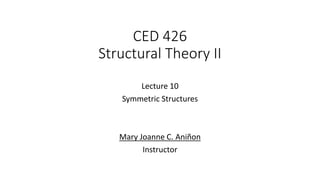Topic2_Symmetric Structures.pptx
•Download as PPTX, PDF•
0 likes•13 views
Theory of Structures II Symmetric Structures Reference: Structural Analysis 10th Edition in SI Units by R.C. Hibbeler
Report
Share
Report
Share

Recommended
Recommended
More Related Content
Similar to Topic2_Symmetric Structures.pptx
Similar to Topic2_Symmetric Structures.pptx (20)
Seismic Response Of Reinforced Concrete Braced Frames

Seismic Response Of Reinforced Concrete Braced Frames
Summary of CHAPTER 6 (ACI318-14M) Structural Analysis

Summary of CHAPTER 6 (ACI318-14M) Structural Analysis
Principale of super position and maxwell reciprocal therom 

Principale of super position and maxwell reciprocal therom
More from Mary Joanne Aniñon
More from Mary Joanne Aniñon (17)
Topic4_Moment Distribution Frames with Sideway.pptx

Topic4_Moment Distribution Frames with Sideway.pptx
Topic4_Moment Distribution with Stiffness Factor Modification.pptx

Topic4_Moment Distribution with Stiffness Factor Modification.pptx
Topic3_Displacement Method of Analysis Frames Sideway.pptx

Topic3_Displacement Method of Analysis Frames Sideway.pptx
Topic3_Displacement Method of Analysis Frames_No-Sideway.pptx

Topic3_Displacement Method of Analysis Frames_No-Sideway.pptx
Topic2_Influence Lines for Statically Indeterminate Beams.pptx

Topic2_Influence Lines for Statically Indeterminate Beams.pptx
Topic1_Castiglianos for Theorem Beams and Frames.pptx

Topic1_Castiglianos for Theorem Beams and Frames.pptx
Topic1_Method of Virtual Work Beams and Frames.pptx

Topic1_Method of Virtual Work Beams and Frames.pptx
Recently uploaded
Process of Integration the Laser Scan Data into FEA Model and Level 3 Fitness-for-Service Assessment of Critical Assets in Refinery & Process IndustriesFEA Based Level 3 Assessment of Deformed Tanks with Fluid Induced Loads

FEA Based Level 3 Assessment of Deformed Tanks with Fluid Induced LoadsArindam Chakraborty, Ph.D., P.E. (CA, TX)
From customer value engagements to hands-on production support, our Services span across every stage of our customers digital transformation journey, to help ensure that every customer is successful in their adoption of our solutions.
• Implementation, Upgrade, Migration, and Maintenance Services
• On-Premises and On-Cloud
• COTS Training Services; On-Site and Virtual
• Software Support Services; Legacy and 3DEXPERIENCE
• Value Engagement & Blueprinting
• Specialized Consulting and Support Services
• Customized Training Services
• Automation and Configuration Services
• Technical Resource Augmentation Services
• Project Management
• Know-how Training (mentoring) and Resource AugmentationNavigating Complexity: The Role of Trusted Partners and VIAS3D in Dassault Sy...

Navigating Complexity: The Role of Trusted Partners and VIAS3D in Dassault Sy...Arindam Chakraborty, Ph.D., P.E. (CA, TX)
Recently uploaded (20)
Tamil Call Girls Bhayandar WhatsApp +91-9930687706, Best Service

Tamil Call Girls Bhayandar WhatsApp +91-9930687706, Best Service
PE 459 LECTURE 2- natural gas basic concepts and properties

PE 459 LECTURE 2- natural gas basic concepts and properties
FEA Based Level 3 Assessment of Deformed Tanks with Fluid Induced Loads

FEA Based Level 3 Assessment of Deformed Tanks with Fluid Induced Loads
Orlando’s Arnold Palmer Hospital Layout Strategy-1.pptx

Orlando’s Arnold Palmer Hospital Layout Strategy-1.pptx
Cara Menggugurkan Sperma Yang Masuk Rahim Biyar Tidak Hamil

Cara Menggugurkan Sperma Yang Masuk Rahim Biyar Tidak Hamil
1_Introduction + EAM Vocabulary + how to navigate in EAM.pdf

1_Introduction + EAM Vocabulary + how to navigate in EAM.pdf
Navigating Complexity: The Role of Trusted Partners and VIAS3D in Dassault Sy...

Navigating Complexity: The Role of Trusted Partners and VIAS3D in Dassault Sy...
Block diagram reduction techniques in control systems.ppt

Block diagram reduction techniques in control systems.ppt
A CASE STUDY ON CERAMIC INDUSTRY OF BANGLADESH.pptx

A CASE STUDY ON CERAMIC INDUSTRY OF BANGLADESH.pptx
Topic2_Symmetric Structures.pptx
- 1. CED 426 Structural Theory II Lecture 10 Symmetric Structures Mary Joanne C. Aniñon Instructor
- 2. Introduction • A structural analysis of any highly indeterminate structure, or for that matter, even a statistically determinate structure, can be simplified provided the designer can recognize those structures that are symmetric and support either symmetric or antisymmetric loadings. • In general, a structure can be classified as being symmetric provided half of it develops the same internal loadings and deflections as its mirror image reflected about its central axis. • Normally symmetry requires the material composition, geometry, supports, and loading to be the same on each side of the structure.
- 3. Introduction • Normally symmetry requires the material composition, geometry, supports, and loading to be the same on each side of the structure. However, this does not always have to be the case.
- 4. • For examples Fig. 9-18a and 9-18b, a pin is required to support the truss and beam for horizontal stability. Here the horizontal reaction at the pin is zero, and so both of these structures will deflect and produce the same internal loadings as their reflected counterpart, thus being classified as symmetric.
- 5. • However, this would not be the case for the frame shown in Fig. 9-18c. If the fixed support at A was replaced by a pin, the deflected shape and internal loadings would not be the same on its left and right sides B C
- 6. Sometimes a symmetric structure supports an antisymmetric loading, that is, the loading on its reflected side has the opposite direction as shown in Fig 9- 19. Provided the structure is symmetric and its loading is either symmetric or antisymmetric, then a structural analysis will only have to be performed on half the members of the structure since the same (symmetric) or opposite (antisymmetric) results will be produced on the other half.
- 7. • In cases where a structure is symmetric and its applied load is unsymmetrical, then it is possible to transform this loading into symmetric and antisymmetric components. • To do this, the loading is first divided in half, then it is reflected to the other side of the structure so that both symmetric and antisymmetric components are produced.
- 8. • When added together as shown in Fig. 9- 20b, these components produce the original loading on the beam. A simpler structural analysis can now be performed using the symmetric and asymmetric loading components, and the results superimposed to obtain the actual behavior of the structure